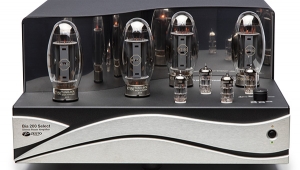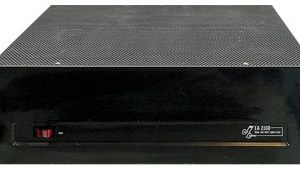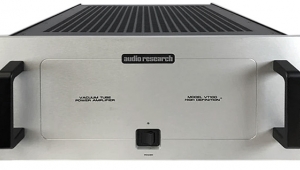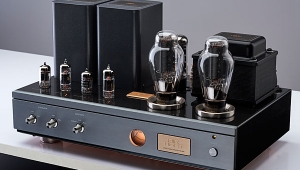| Columns Retired Columns & Blogs |
Wavac SH-833 monoblock power amplifier Page 3
That's because the SH-833s met challenges such as The Clash's masterfully recorded London Calling (LP, CBS CLASH3) by rendering the drum kit with sufficient slam and crackle to avoid the sensation of muffled softness, while adding weight to each percussive hit—whether cymbals, toms, snare, or kick drum. The overall effect was to make the kit sound far more like a live event than I was used to experiencing from this disc, even though it ever so slightly mellowed the tonal expression at the very top.
Bass presentation was equally sensational, if unusual: bigger and warmer than I was used to—which it needed to be to match the voluptuous midband—but not sloppy or weak or incoherent. In fact, listening to the Weavers' Reunion at Carnegie Hall 1963 (45rpm LPs, Vanguard/Classic), I heard something for the first time that amazed me. Pete Seeger can be heard tapping his foot at the right of the stage during "Guantanamera." I've heard those foot-taps for decades, but through the SH-833s, for the first time I could hear—and clearly—that Seeger was accentuating the third beat in each bar. I could also make out how far the vibration spread across the floorboard before dissipating.
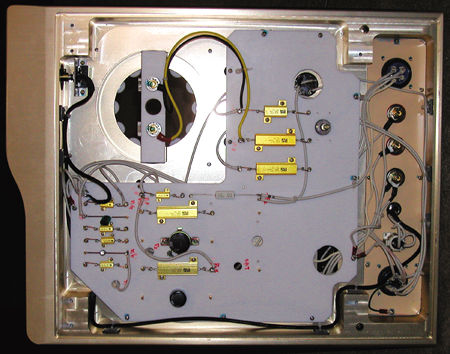
This was not a musically significant event, but it pointed out to me that while the SH-833s' midbass was big, voluptuous, somewhat rich, and less well damped than you typically get with a solid-state amp, it was sufficiently well-controlled and delicate to delineate heretofore hidden details. Had the bottom end been any more damped or the top end any faster, the picture's coherence would have suffered.
Speaking of the whole picture: One afternoon I was out running errands when Roger Waters' Amused to Death (Columbia 46876) popped into my head. I hadn't played the LP in probably a decade, and I don't know which made me think of it—the album's sonic brilliance, or its ruminations on "dramatic foreign policy" and the ability to watch a war on TV, which Waters satirizes as a sporting event complete with a Marv Albert play-by-play. (Amused to Death was released in 1992, around the time of the first Iraq war.)
The press kit that came with the promo CD described Amused to Death as "a wide-screen, Technicolor cinema for the ears," and for once a recording lived up to its hype—it delivered all of the sonic and dramatic impact I'd hoped for. Of course, it was only because I'd bought the two-LP set, mastered by Doug Sax directly from the original analog tapes that I had access to far more spectacularly natural, rich, dynamic sound.
Dynamics? Yes. Perhaps the SH-833s didn't measure up to the sledge-hammer authority of the Musical Fidelity kW monoblocks, but I never felt as if the Wavacs ran out of steam, or shortchanged any of the large-scale symphonic recordings I played. Low-level dynamics were equally well served: lithe, nimble, and delicate.
Put it all together and I got a sonic spread of unparalleled richness, coherence, and enormity of scale—when the music made that appropriate. I heard a program of Berlioz and Sibelius symphonic music in Avery Fisher Hall, then ran home and fired up the system. What I then heard was far closer to a living reality than I'd ever experienced before when making such a quick comparison. I doubt you'll ever experience recorded strings sounding as convincingly real as you'll hear through these amplifiers.
Yet when I put on something meant to be lively, rocking, and intimate, such as Memphis Slim's Tribute to Big Bill Broonzy, LeRoy Carr, Cow Cow Davenport, Curtis Jones, Jazz Gillum (LP, Candid 9023), recorded at Nola Penthouse Studios in 1961, the SH-833s delivered the singer's voice and piano slightly bright and forward, with the crispness and lightness to which I was accustomed but with a noticeably creamier and more transparent midrange that made this familiar recording sound far more convincing and translucent than I'd ever heard it.
Given the Wavacs' sonic personality, I wished I still had the Aerial 20T speakers that I reviewed in April. $350,000 doesn't buy you ultimate compatibility; I don't think the WATT/Puppy 7s, with their craftily placed 50Hz midbass bump, were the ideal match for the SH-833s, though the match was magical nonetheless—especially after I replaced the WATTs' standard port with the one intended to be used with tube amps. The Aerial 20T, with its hyper-detailed and extended ribbon tweeter and flatter, deeper, better-damped bass extension, might have combined with the Wavac to produce even more memorable sound.
The midrange transparency and purity delivered by the Wavacs made driving them directly from the Manley Steelhead's variable output, rather than through the Musical Fidelity kWP preamp, a much better choice. While almost transparent, the kWP imparted a bit of unnecessary warmth and a slight opacity. The newest Steelhead includes a line input, so it was easy to play both analog and digital while bypassing the preamp altogether. That's how the system sounded the most open, airy, coherent, three-dimensional, and, especially, transparent.
Though most LPs and CDs I played during that magical month did not disappoint, a few did. That's to be expected with such a singular product as the Wavac SH-833 in the system. I don't care how much you spend—some recordings respond magically to certain systems, some just don't. But very few discs, analog or digital, didn't deliver on the promise of these stunning amplifiers.
Conclusions
Slightly on the mellow side up top, a bit warm down below, the Wavac SH-833 seamlessly filled in the midband with a rich, transparent, detailed sound that managed to unite the entire audible bandwidth into a whole that was coherent, transparent, rich, and round.
You'll hear more extended amplifiers on top, better-damped ones below, and more powerful, punchy, and dynamic ones all around. But I doubt you'll hear an amplifier that delivers the effervescence, transparency, and solidity of live music—all kinds of live music—as convincingly and effectively as does the Wavac SH-833.
Could the enormity of the Wavacs' soundstage and my inability to identify sound as actually emanating from a pair of speakers be a function of the amps' slightly warm midbass and ever so gently softened top end? Could be. What's important in the end is the totality of the experience, and that was totally awesome. I suppose the distortion levels at or near rated output will be far higher than those of run-of-the-mill solid-state amps, but those numbers tell only part of the story—which is why higher-distortion tube gear is gaining more and more acceptance in recording studios. Speaking of numbers: If $350,000 is too rich for your bank account, the SH-833 is also available as the HE-833 v1.3, which doesn't include the isolation transformer and grandiose power supply, for a mere $69,000.
The SH-833 is absurdly expensive. Only a few lucky audiophiles have pockets deep enough to afford them, and given the amp's distinctive personality, associated components must be chosen with great care. But when everything is right, the Wavac SH-833 will produce magical, musically fulfilling sound that you're not likely to forget. If I had a good third of a million bucks to burn, I'd do it—before I'd spend it on a painting or a sports car. And I like driving fast cars.
I begged for another month with the magical Wavacs. I was lucky enough to get it.
- Log in or register to post comments
